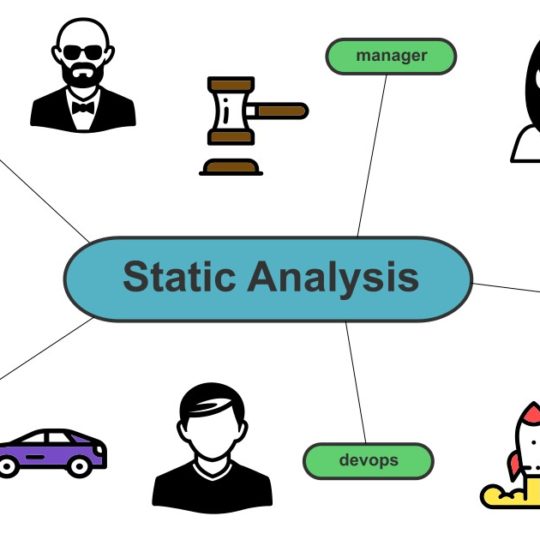What is static code analysis?
The process of static code analysis scans for potential software code defects without executing the program. While this procedure can ensure proper coding standards are adhered to, more importantly, it can locate security flaws and performance issues early in the development lifecycle. Various tools are available for many languages and typically utilized during local development through an IDE and automated as part of the build pipeline. Introducing this process into the development lifecycle will benefit the developers, the team and the organization.
Static code analysis is essential to operating an efficient software development team. When proper rules are in place, these tools can check for known issues before code is committed and put up for review by other developers. Since defects get more expensive to resolve the longer they exist in the codebase, finding potential issues as early as possible will directly correlate to time and cost savings. Static and dynamic testing are both essential in maintaining high code quality.
How does it work?
A static code analyzer evaluates the source code when the program is not running – hence the name static. Most of these tools will use various techniques that analyze the AST (abstract syntax tree). The AST is a model of the code that ignores unimportant aspects like indentation or end-line characters. Specifically, the compilation process builds the tree where the layout represents structures such as loops, if-else conditions and all the various computations.
These tools utilize the AST to check control and data flow, among other use cases. For example, by analyzing the code’s control flow, static analysis tools can identify issues such as unreachable code, infinite loops, and other control flow anomalies that could lead to unexpected behaviour. They can also track data flow through the program, identifying potential issues such as uninitialized and unused variables.
What can it do?
Static code analysis tools can check for performance issues, security vulnerabilities, and best practices. Although code that is non-compliant with generally accepted best practices could still serve its intended purpose, enhancing the readability and maintainability of the source code benefits all current and future developers contributing to the codebase.
Some performance issues might only become problematic at scale, which will also become more challenging to debug. However, if a tool can recommend more efficient ways of accomplishing the same result, we can mitigate the risk of minor performance problems becoming substantial problems. Unless regular load testing is an established part of the development process, performance problems usually show themselves at the worst time, such as the launch of an extensive marketing campaign.
Security remains a top priority as businesses continue to operate in an increasingly digital environment. Static application security testing (SAST) is an effective tool for ensuring secure systems. SAST is a static code analysis identifying potential security vulnerabilities early in the coding process. While other forms of security testing are also necessary, avoiding known vulnerabilities during the initial coding phase provides a crucial first line of defence. Even experienced developers may miss specific issues, such as SQL injection, but requiring entry-level developers to use automated tools can help prevent such vulnerabilities from being introduced in the first place.
These tools can calculate various metrics related to the code, such as cyclomatic complexity and maintainability index. These scores can help developers improve the code’s quality and maintainability. Additionally, by checking the code against established coding standards and analyzing how it uses external APIs, static analysis tools can identify issues such as coding style violations, unsafe coding practices, and buffer overflow vulnerabilities.
How can it help a developer?
The earliest opportunity for a static analysis tool to be useful is when each developer utilizes it through their chosen IDE. Using it in this manner provides immediate feedback to the developer when potential issues arise. Developers of all experience levels can benefit from this, not just people starting in the industry. By giving timely feedback when developers are in the middle of their creative process, they can use these tips to improve their overall code quality.
Some tools will also keep an up-to-date library of vulnerabilities and clearly describe how these issues can introduce security concerns. Using examples within the context of their current code, developers can further their knowledge about concepts they wouldn’t otherwise be aware of. The ability for developers to learn quickly and apply their new insights efficiently will serve them well in an industry with so much to know.
How can it benefit the team?
Using automated tools to check for known issues alleviates problems that inevitably get past error-prone humans during a traditionally manual process. As a system grows and becomes more complex, the ability of a team to confidently review every possible use case for regression issues becomes infeasible. While unit, integration, end-to-end, and manual testing are still needed to verify desired functionality, developers should welcome any tools to help with finding vulnerabilities from a non-functional perspective.
Having a proper set of code style guidelines is a meaningful part of ensuring everyone on a development team can consistently contribute code of the same quality to their respective services. In addition, when onboarding new team members, any automated process that can get them up to the team standard will be more effective for everyone. For example, they may be a great fit and have relevant experience with a similar product. However, they need to gain more programming language knowledge. Having a static analysis tool already set up with a chosen set of rules established, they have a much greater chance of contributing quality code sooner.
There are clear cross-team benefits as well. For example, when separate QA or security teams are involved in the quality control process, pre-checking code against issues inevitably saves all groups a lot of time. In addition, cross-team collaboration typically takes more effort than inter-team; therefore, minimizing unnecessary back-and-forth with other teams improves efficiency. It is even more powerful when the groups responsible for ensuring quality, performance, and security establish the code guidelines in their respective areas.
How can it serve the organization?
The business benefits from static analysis in all the same ways mentioned above. For example, increasing individual team efficiency or minimizing unneeded cross-team collaboration will save the entire organization time. Improving the code’s readability and maintainability also saves time, although this is difficult to measure. In addition, by limiting the number of bugs that make their way into production, the organization is also saving money since these problems become more expensive to fix the further down the development lifecycle they progress.
Compliance with security or privacy regulations is of great concern to any organization. Every company will fall under some regulatory framework, such as; PCI-DSS, SOC-2, HIPAA, or GDPR, to name a few. Achieving certification and abiding by these frameworks is a significant undertaking and requires continual efforts to stay within the required guidelines. Therefore, any automated tools that help ensure all codebases remain compliant will be a welcomed addition to the overall strategy.
Whether a security vulnerability or privacy breach falls under any regulation, static analysis tools will help mitigate the risk. Consequently, regardless of the organization’s size or the products and services they offer, any infringement can cause harm to its reputation. A simple technique like static analysis can help avoid the situation, whether the result is, at best, a minor embarrassment or, at worst, legal action.
Why is static code analysis important?
In summary, establishing an automated tool with rules applicable to the product will benefit the developer, the team, and the organization. Furthermore, this simple aspect of software development can be a precious asset for individual developers furthering their knowledge and allowing the company to mitigate the risk of failing regulatory compliance. Therefore, evaluating the many options available and their impact is a worthwhile endeavour for all companies developing software.
While your overall quality process should contain static analysis, issues such as false positives, cost, and effort to implement need consideration. Read more about some of the limitations here – What are the limitations of static code analysis?






